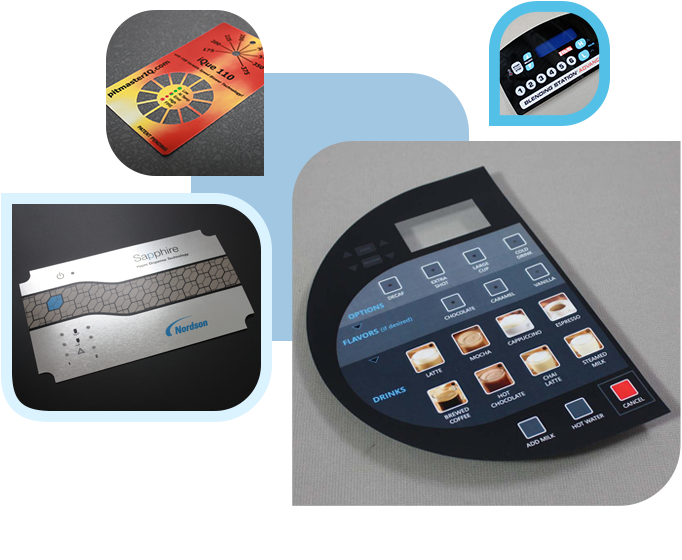How to Pick the Right Graphic Overlays for Your Product Uses
How to Pick the Right Graphic Overlays for Your Product Uses
Blog Article
Recognizing Just How Graphic Overlays Work to Enhance Your Creative Tasks
Graphic overlays offer as a crucial element in the world of creative jobs, boosting both aesthetic communication and audience involvement. The effective combination of these overlays requires mindful consideration of layout principles and purposes.
What Are Graphic Overlays?
Graphic overlays are visual components that are put on top of a base picture or user interface to improve communication and individual experience. They offer numerous purposes, consisting of supplying extra details, guiding individual interaction, and boosting visual charm. Usual applications of visuals overlays can be located in electronic interfaces, advertising, and instructional products.

Graphic overlays are frequently created using style software, allowing designers to adjust transparency, dimension, and shade to achieve the wanted impact. Recognizing just how to properly implement graphic overlays is crucial for developers intending to raise their creative jobs.

Benefits of Using Graphic Overlays
Utilizing visuals overlays can significantly enhance the effectiveness of visual communication across different tools. One of the main advantages is the ability to communicate intricate information succinctly. By layering graphics, message, and photos, overlays facilitate the discussion of information in a much more digestible layout, making it less complicated for audiences to grasp crucial principles rapidly.
In addition, graphic overlays can enhance visual charm, accentuating particular elements within a design. This is specifically helpful in marketing and advertising, where capturing the viewer's rate of interest is critical. The calculated usage of colors, forms, and typography in overlays can create a cohesive and interesting aesthetic narrative, improving brand name acknowledgment.
In addition, visuals overlays give adaptability in style. They permit creators to adjust content for various systems without going back to square one, guaranteeing consistency across various channels. This versatility is essential in today's electronic landscape, where content must be maximized for diverse gadgets and formats.
Types of Graphic Overlays
When considering the different kinds of graphic overlays, it is vital to recognize their varied applications throughout different markets. Graphic overlays can be classified mainly into three kinds: useful, attractive, and informative.
Functional overlays are designed to improve the usability of an item. Generally located in electronic gadgets, these overlays often give tactile feedback with elevated switches or distinctive surface areas, boosting individual interaction. They can also function as a protective layer, safeguarding the underlying components from wear and tear.
Decorative overlays concentrate on visual enhancement, allowing brand names to express their identification via dynamic designs and personalized graphics. These overlays are prevalent in product packaging, advertising, and point-of-sale products, where visual charm is essential for bring in customers.
Educational overlays, on the other hand, are utilized to communicate important data or guidelines. They can be seen in applications such as signs, customer handbooks, and training graphics, where clearness and readability are critical.
Each kind of visuals overlay serves an one-of-a-kind objective, contributing to the overall performance of innovative projects while attending to certain requirements within numerous industries. Recognizing these differences is vital for choosing the best overlay for your job.
Best Practices for Execution
To ensure the effective implementation of graphic overlays, it is crucial to establish a clear understanding of the task's objectives and the specific requirements of the end-users. Begin by performing comprehensive research to determine the target market and their choices, as look these up this will certainly educate layout visit the site selections and capability.
Following, create an in-depth strategy that details the overlay's layout, integration, and function procedure. This strategy must include interface factors to consider, making sure that overlays improve instead of obstruct the user experience - Graphic Overlays. Preserve and take into consideration the aesthetic hierarchy uniformity in design elements, such as color schemes, typefaces, and icons, to promote brand comprehensibility
Evaluating is crucial; gather responses from a representative example of users to recognize potential concerns and areas for renovation. Repeat on the layout based on user input and efficiency information. Furthermore, make sure compatibility across different gadgets and platforms to optimize accessibility.
Devices for Creating Overlays
Developing efficient graphic overlays needs the right tools to translate design ideas into functional applications. Different software application and systems are readily available, each tailored to details requirements and ability degrees.
Adobe Photoshop and Illustrator are market criteria, using substantial capabilities for developing and controling overlays. These tools give innovative features such as layer management, mixing settings, and vector graphics, making it possible for developers to develop detailed and top notch overlays.
For those looking for a much more user-friendly strategy, Canva and Figma are exceptional options (Graphic Overlays). Canva's intuitive interface permits individuals to develop overlays quickly making use of pre-designed layouts, while Figma assists in collaborative design in real-time, making it perfect for groups
Furthermore, open-source choices like GIMP and Inkscape provide durable functionalities without the associated costs of proprietary software program. These devices enable versatility in style and can accommodate different data layouts, guaranteeing compatibility across different systems.

Verdict
Finally, visuals overlays function as effective tools for enhancing creative jobs by offering visual quality, aesthetic allure, and brand name uniformity. Their diverse applications, ranging from useful to decorative, underscore their versatility in communication. Sticking to ideal methods and making use of visit the website appropriate devices makes certain efficient execution and makes the most of the influence of overlays. By recognizing the essential principles and benefits connected with visuals overlays, creators can considerably boost the high quality and effectiveness of their aesthetic interactions.
Graphic overlays offer as a critical part in the world of imaginative jobs, improving both aesthetic communication and audience interaction.Graphic overlays are often produced making use of layout software, enabling developers to adjust openness, color, and dimension to achieve the wanted impact.Furthermore, graphic overlays can increase aesthetic appeal, drawing interest to details aspects within a layout.Furthermore, visuals overlays offer adaptability in style.In final thought, visuals overlays serve as effective devices for improving creative jobs by offering visual clearness, visual allure, and brand consistency.
Report this page